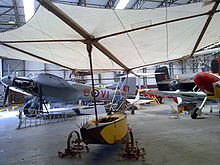Derek Piggott
Derek Piggott | |
|---|---|
 Derek Piggott in his natural habitat at the Lasham Regional Competition in 2005 | |
| Born | Alan Derek Piggott 27 December 1922 Chadwell Heath, Essex, England |
| Died | 6 January 2019 (aged 96) |
| Nationality | English |
| Citizenship | United Kingdom |
| Occupation(s) | Aviator, flying instructor and author |
Alan Derek Piggott
Early years
Piggott was born in Chadwell Heath, Essex, the son of Rev. William Piggott and Alice Harvey. His father was a conscientious objector in the First World War, led the rent strike against London County Council after the war, and was a frequent speaker at Hyde Park. When his mother died, the family moved to Sutton, Surrey, where Derek attended Sutton County School. When he left school he became a trainee scientific instrument maker. He had been a very active aero-modeller and helped to form the Sutton Model Aircraft Club. After the war he was selected to be a member of the British Wakefield Cup team, a prestigious aero modelling competition held that year in Akron, Ohio. He first flew in an Avro 504 as a passenger at the age of four.
Royal Air Force
Piggott joined the
Back in the UK he was posted as a Staff Instructor at the
Gliding career
In 1953, he left the RAF as a
In addition he had success as a competition glider pilot winning three regional championships, was the UK National aerobatic glider champion in 1961, and set several national gliding records including the single-seat altitude record of over 25,000 feet (7,600 m) in an active thunderstorm in a
He was a member of a test group for the British Gliding Association (BGA) and tested a number of prototype gliders and foreign machines for approval to be imported. He made a successful emergency parachute descent from a damaged SZD-9 Bocian making him a member of the Caterpillar Club. He researched the effect of sub-gravity sensations as a cause for many serious and fatal gliding accidents.
Other flying
On 9 November 1961, flying
He took a break from being a gliding instructor to become a stunt pilot
In
Another notable film role, was Derek Piggott's contribution to Those Magnificent Men in Their Flying Machines in which he flew and advised on the construction of several of the early aircraft recreated for use in the film. Many of the planes employed wing warping for control in roll, which involved re-discovering how to fly them safely without the better roll control that comes from the use of ailerons. Several of the aircraft had dangerous features and he had a number of narrow escapes.
In Villa Rides he had to crash an aircraft that was flying towards a cliff by making the undercarriage collapse. This stopped it from 110 km/h (68 mph) in about 10 m (33 ft)

Derek Piggott flew some or all the aerial stunts in several other films:
Von Richthofen and Brown (The Red Baron);
Agatha;
Slipstream;
You Can't Win 'Em All;
Piggott Hook
Derek Piggott was the inventor of the "Piggott-Hook", which is designed to prevent air brakes opening on a launch. The system is installed in all new gliders built by DG Flugzeugbau[8]
Death
Piggott died of a stroke, aged 96, on 6 January 2019.[9]
Honours
In 1987 Derek Piggott was appointed a
Bibliography
- Piggott, Derek (1977). Delta Papa A Life of Flying. Pelham Books. ISBN 0-7207-0979-2.
- Piggott, Derek (1978). Going Solo: A Simple Guide To Soaring. A & C Black. ISBN 0-7136-1899-X.
- Piggott, Derek (2002). Gliding: A handbook on soaring flight. A & C Black. ISBN 0-7136-6148-8.
- Piggott, Derek (1998). Gliding Safety. A & C Black. ISBN 0-7136-4853-8.
- Piggott, Derek (1999). Understanding Flying Weather. A & C Black. ISBN 0-7136-4346-3.
- Piggott, Derek (2002). Understanding Gliding. A & C Black. ISBN 0-7136-6147-X.
- Piggott, Derek (2002). Beginning Gliding. A & C Black. ISBN 0-7136-4155-X.
- Piggott, Derek (1990). Derek Piggott on Gliding. A & C Black. ISBN 0-7136-5799-5.
His monographs are:
- 'Sub-gravity sensations and gliding accidents'
- 'Stop worrying about stalling and spinning'
- 'Using motor gliders for training glider pilots'
- 'Ground launches'
References
- ^ "No. 40366". The London Gazette (Supplement). 31 December 1954. p. 36.
- ^ Piggott, Derek. "List of 'Derek on Instructing'". glidingmagazine.com. Archived from the original on 11 July 2011. Retrieved 14 August 2015.
- ^ "BBC News web-site". 12 November 2011. Retrieved 15 November 2012.
- ^ "THE FIRST TRUE FLIGHTS SUMPAC". Archived from the original on 19 May 2011. Retrieved 3 January 2018.
- ^ "IMDB". Retrieved 3 January 2018.
- ^ Piggott, Derek (October 2003). "Gliding 1852 Style". glidingmagazine.com. Archived from the original on 17 July 2012. Retrieved 14 August 2015.
- ^ Short, Simine (October 2003). "Stamps that tell a story". glidingmagazine.com. Archived from the original on 29 July 2012. Retrieved 14 August 2015.
- ^ "The Piggott-Hook for locking the Brake Handle or How an Invention Begins". dg-flugzeugbau.de. Archived from the original on 23 September 2015. Retrieved 14 August 2015.
- ^ "Derek Piggott, gliding legend and pilot, RIP". FLYER. 7 January 2019. Retrieved 7 January 2019.
